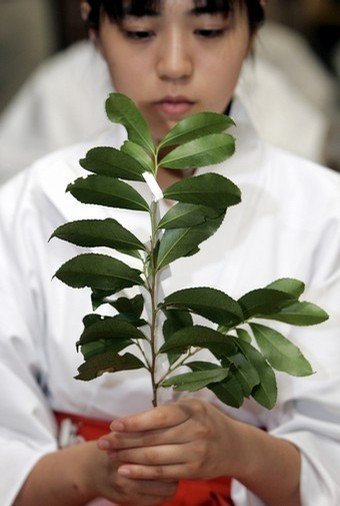Sakaki tree is a tree with lush green leaves that are found in mythology, literature andsacred rituals in Japan.

In the spring, Sakaki tree fragrances issued by the falling white flowers followed byfruit-shaped appearance of small dark red. This tree grows in warm temperate partsof Japan, Korea and China.
Kojiki (Ancient books) is a very valuable record for the Shinto religion and thought to originate from the 8th century.
Based on the writings and other references from Japanese mythology, Sakaki treehas a significant role in the story of the creation of Japan. In ancient times the holy lifepartner named Izanagi and Isanami that makes the Japanese islands and their children to the gods in various Japanese clans.
Their daughters, Amaterasu (Goddess who shines great nan) was born from the left eye of his father who eventually became the Sun Goddess. From this goddess of theJapanese imperial family to admit they came from.
His brother Susanoo, god of the storm given the task to lead the ocean, but beforegoing Susanoo destroyed rice fields and causing Amaterasu ravaged homes.
Feeling upset and angry, Amaterasu finally went to a cave and shut down. This led the world into darkness.

To lure Amaterasu out of hiding, the gods finally bring Sakaki tree branch 500 of Mount Kaga in heaven to put on the front door of the cave was inhabited by Amaterasu.
At the top of a tree branch mounted 500 jewel Sakaki, medially placed mirror with eight-foot tall and at the bottom of the tree in place the various offerings.
The gods then making noise and having fun outside the cave. Amaterasu was curious why the gods are still able to rejoice when the world was pitch black.
From outside the gods say that there exists a more shining goddess Amaterasu from ourselves. Feeling very curious about the competitors Amaterasu came out and saw her reflection from the mirror in the tree Sakaki.
Before realizing he was being set up, the gods throw shimenawa or sacred rope of straw before the door closed cave. Finally the world is again light and life continues.
Amaterasu Besae worshiped at Ise Shrine which is the main temple in Japan.Goddard is manifested in the mirror, which is one of the three imperial treasures of Japan.
Sakaki itself in place in shinno-mihashira or places sacred center located at the top and surrounded by the temple building made of wood. Sakaki tree usually fitted with a mirror-mirror on the other Shinto shrine.
Sakaki tree often used as a metaphor in the literature and the works of art in Japan.Sakaki is also mentioned in a fragment of an ancient religious writings that mention that this tree represents loyalty and stability while also expressing the eternal presence and power of the goddess in the temple.
Various keagaaman Shinto ceremony in the ritual use Sakaki tree. In a sacred ceremony called gohei ribbon, hang a rope of straw or twigs from a tree sacred sacred Sakaki used to invoke the presence of the holy spirit.
Gohei also known as Oho-nusa or holy offerings and still used in many important religious ceremonies in Japan.
Oho-nusa using two sticks linked together and connected with a straw and a few pieces of paper. One stick is made of wood and other Sakaki tree of bamboo.
In addition, the symbol of worship in Izumo area involving Sakaki leaves tied on top of prayer banners called nobori. In the Izumo temple there are many nobori that adorn the temple area with a white color.
Sumber
Posted by , Published at 17.10 and have
0
comments
Tidak ada komentar:
Posting Komentar